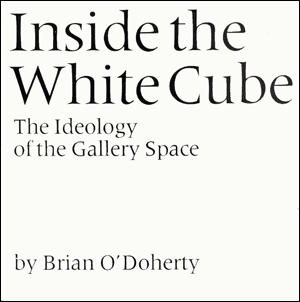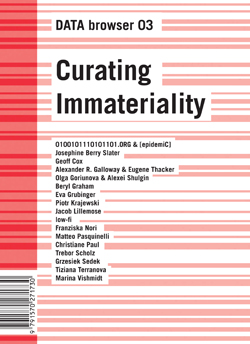Brian O’Doherty: Inside the White Cube: The Ideology of the Gallery Space (1976–) [EN, BR-PT, ES]
Filed under book | Tags: · art, art criticism, art history, art system, exhibition, installation

“When these essays first appeared in Artforum in 1976, their impact was immediate. They were discussed, annotated, cited, collected, and translated–the three issues of Artforum in which they appeared have become nearly impossible to obtain. Having Brian O’Doherty‘s provocative essays available again is a signal event for the art world. This edition also includes “The Gallery as Gesture,” a critically important piece published ten years after the others.
O’Doherty was the first to explicitly confront a particular crisis in postwar art as he sought to examine the assumptions on which the modern commercial and museum gallery was based. Concerned with the complex and sophisticated relationship between economics, social context, and aesthetics as represented in the contested space of the art gallery, he raises the question of how artists must construe their work in relation to the gallery space and system.
These essays are essential reading for anyone interested in the history and issues of postwar art in Europe and the United States. Teeming with ideas, relentless in their pursuit of contradiction and paradox, they exhibit both the understanding of the artist (Patrick Ireland) and the precision of the scholar.”
The essays originally appeared in Artforum magazine, 1976
With an Introduction by Thomas McEvilley
Publisher Lapis Press, San Francisco, 1986
Expanded edition, 1999
ISBN 0520220404
113 pages
Inside the White Cube (English, 1986, 4 MB, added on 2020-3-18)
Inside the White Cube (English, exp.ed., 1999, 6 MB, updated on 2020-3-18)
No interior do cubo branco: a ideologia do espaço da arte (BR-Portuguese, trans. Carlos S. Mendes Rosa, 2002, 158 MB, added on 2016-6-16)
Dentro del cubo blanco (Spanish, trans. Lena Peñate Spicer, 2011, 24 MB, added on 2015-12-30)
Joasia Krysa (ed.): Curating Immateriality: The Work of the Curator in the Age of Network Systems (2006)
Filed under book | Tags: · aesthetics, art, collaboration, curating, database, exhibition, internet, internet art, labour, media art, museum, net art, open source, relational aesthetics, software art, technology

“The site of curatorial production has been expanded to include the space of the Internet and the focus of curatorial attention has been extended from the object to processes to dynamic network systems. As a result, curatorial work has become more widely distributed between multiple agents, including technological networks and software. This upgraded ‘operating system’ of art presents new possibilities of online curating that is collective and distributed — even to the extreme of a self-organising system that curates itself. The curator is part of this entire system but not central to it.
The subtitle of the book makes reference to the essay ‘The Work of Culture in the Age of Cybernetic Systems’ (1988), in which Bill Nichols considered how cybernetics transformed cultural production. He emphasised the shift from mechanical reproduction (symbolised by the camera) to that of cybernetic systems (symbolised by the computer) in relation to the political economy, and pointed to contradictory tendencies inherent in these systems: ‘the negative, currently dominant, tendency toward control, and the positive, more latent potential toward collectivity’. The book continues this general line of inquiry in relation to curating, and extends it by considering how power relations and control are expressed in the context of network systems and immateriality.
In relation to network systems, the emphasis remains on the democratic potential of technological change but also the emergence of what appears as more intensive forms of control. Can the same be said of curating in the context of distributed forms? If so, what does this imply for software curating beyond the rhetoric of free software and open systems?”
Contributors: 0100101110101101.ORG & [epidemiC] | Josephine Berry Slater | Geoff Cox | Alexander R. Galloway & Eugene Thacker | Olga Goriunova & Alexei Shulgin | Beryl Graham | Eva Grubinger | Piotr Krajewski | Jacob Lillemose | low-fi | Franziska Nori | Matteo Pasquinelli | Christiane Paul | Trebor Scholz | Grzesiek Sedek | Tiziana Terranova | Marina Vishmidt
Publisher Autonomedia/I-DAT, 2006
Creative Commons License
DATA browser series, 3
ISBN 1570271739
288 pages
PDF (14 MB, added on 2018-3-29)
PDFs (updated on 2016-12-12)
This Is Tomorrow (1956)
Filed under catalogue | Tags: · 1950s, architecture, art, art history, exhibition, pop art, united kingdom

“This Is Tomorrow was a seminal art exhibition in August 1956 at London’s Whitechapel Art Gallery, facilitated by curator Bryan Robertson. The core of the exhibition was the ICA Independent Group.
It has become an iconic exhibition notable not only for the arrival of the naming of Pop Art but also as a captured moment for the multi-disciplinary merging of the disciplines of art and architecture.
The exhibition included artists, architects, musicians and graphic designers working together in 12 teams—an example of multi-disciplinary collaboration that was still unusual. Each group took as their starting point the human senses and the theme of habitation.
The exhibition catalogue featured essays by Reyner Banham and Lawrence Alloway. McHale wrote the text for the page Are they Cultured? and it was intended to be featured with the McHale designed collage that got mispaginated in the catalogue.”
Edited by Theo Grosby
Designed by Edward Wright
Commentary: this is tomorrow 2 (2008), James Lingwood (2009).
Reinterpretation (2019)
Wikipedia
HTML (the website is down as of 2019-3-15)
Comments (2)
